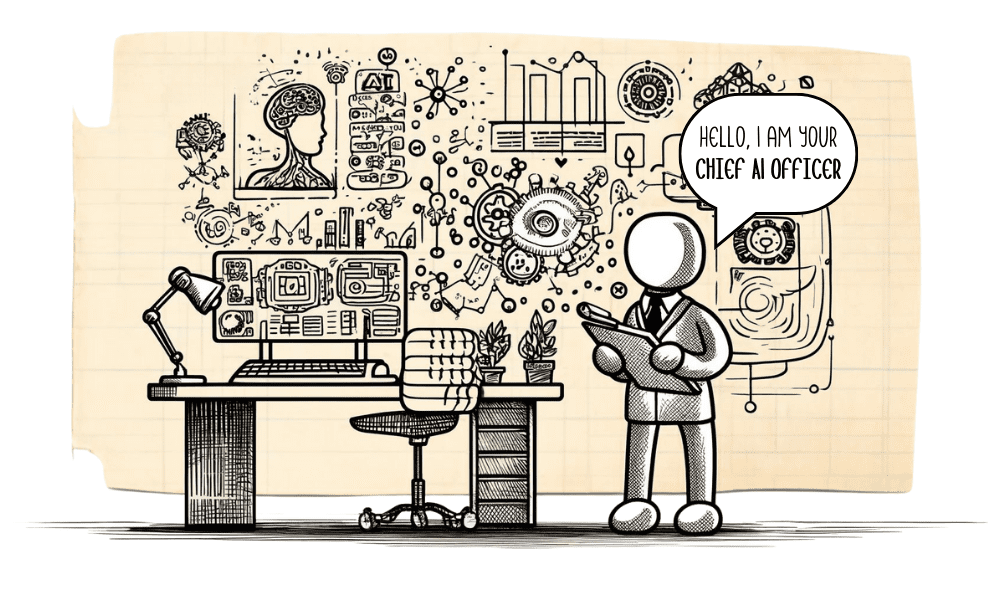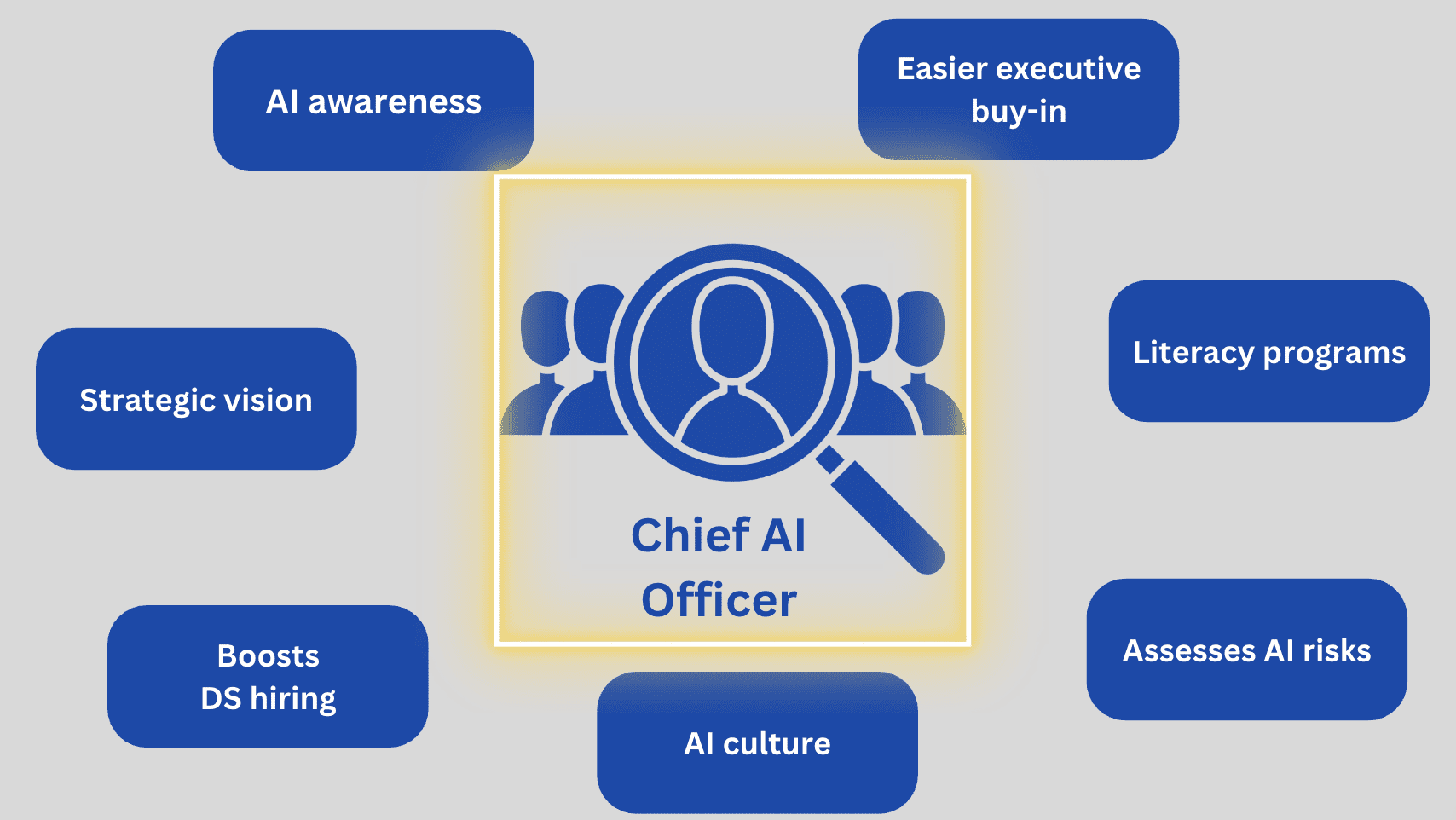The recent news of adding CAIOs led to everyone talking about this role in creating safeguards around AI.
While the title sounds appealing, it comes with its share of uncertainty in terms of expectations and responsibilities.

Image by Editor
While bringing its unique distinctive capabilities to the table, this role sits at the intersection of many key roles, such as business executives, legal advisors, Chief Technology Officer (CTO), and Chief Data Officer (CDO) among others.
Aligning AI strategy with the business prerogatives, the CAIO also discusses the need (and plan) to modernize the existing architecture to be AI-ready, advising and overseeing the tech-maturity level with the CTO. Additionally, this AI executive role is also responsible for safeguarding AI initiatives while ensuring that are commercially viable, aligning with the CFO office.
Put simply, singular AI leadership is essential to effectively integrate AI into business and redefine the legacy way of business.
Now that we are aware of how this role interacts with its peers, let’s see why is there a need for such a role now. Why haven’t we heard more about CAIOs before?
In addition to the announcement of the importance of this role from the Biden administration, the rate at which the field of AI is evolving demands an AI executive who can sense the leading indicators of where the technology is headed, develop the innovation muscle at the enterprise and execute the ever-evolving roadmap faster than the competition.

Source: federaltimes.com
It is like preparing the organization to reap the benefits of leveraging AI most effectively and efficiently; instead of waiting on industry leaders to indicate the best use of this technology.
Supporting this belief with numbers, there has been an increasing trend in the title “Chief AI Officer” on LinkedIn, starting from 250 in 2020 to 781 such positions from the latest search.
It won’t be wrong to say that the companies investing in CAIO decisions are well-prepared to embrace AI technology and witness business growth in the coming years.
The CAIO can make everyone AI-aware, including peer executives, and contribute significantly to AI literacy programs. It is similar to creating an AI council, spearheaded by CAIO, that creates awareness and brings everyone together to take a collective call on leveraging AI to reshape their business.
One may argue for adding another executive position who needs to partner with their fellow peers to bring out the synergies, however identifying the AI opportunities without assuming unwanted risk requires expertise, which is materialistically different than running business as usual (BAU).
The CAIO comes with domain knowledge which powered by their systematic approach to adopting AI helps everyone align on picking the right initiatives, rather than going all over the place.

Image by Author
AI should never be something that is done for PR campaigns or just another checkboxing activity. It requires an executive who has a laser-sharp focus on overseeing its development and adoption responsibly.
Building an AI Culture
AI is not something that is done overnight. It is indeed a multi-year transformation journey that finds its roots in setting the right culture and taking everyone together. This one strategic hire can weave AI into the fabric of your whole organization.
- Attracting AI talent is a big challenge in itself; however, the problem aggravates quickly when the organizations that are struggling with their AI roadmap begin to lose their data scientists. And, it is rightly so. The field demands keeping oneself up-to-date with the latest technology trends and being hands-on too. The moment DS teams realize that the company’s AI vision is more of a fancy aspiration rather than a strong business proposition, they would soon make a move. Hence, the presence of a CAIO solidifies the AI vision as well as affirms the team’s confidence that everyone’s working in the right direction toward making a meaningful business impact.
- CAIO knows the language of AI and can articulate the technical requirements to DS and Engineering teams effectively. Such communication plays a crucial role in the seamless development cycle of AI products, reducing unnecessary iterations arising due to a lack of AI expertise.
- One of the major issues that deter the progress of AI initiatives is executive buy-in. With the introduction of CAIOs, the buy-in becomes easier as the organization already has an AI executive who can communicate the possibilities with AI.
There is so much more to add to highlight the value-addition that this role brings, something that I will cover in a follow-up post, however, one thing is clear.
CAIOs are not just another fancy designation on board. They build and execute an AI strategy by deriving it from a business strategy and working in tandem with a data strategy.
Even if there are several other potential contenders like CDOs and CTOs that can extend themselves to this role, it is crucial to note that CAIOs carry the necessary expertise to perform the due diligence that AI demands and are aptly equipped to handle the unique challenges that come with AI.
Ultimately, it is not just about a title. Every organization might have a different designation that corresponds to CAIO. Their version of CAIO might be a VP, SVP, Director, or Head of AI doing the same work already.
It is more about the depth of knowledge and the ability to drive innovation and transformation in AI initiatives.
Vidhi Chugh is an AI strategist and a digital transformation leader working at the intersection of product, sciences, and engineering to build scalable machine learning systems. She is an award-winning innovation leader, an author, and an international speaker. She is on a mission to democratize machine learning and break the jargon for everyone to be a part of this transformation.
- SEO Powered Content & PR Distribution. Get Amplified Today.
- PlatoData.Network Vertical Generative Ai. Empower Yourself. Access Here.
- PlatoAiStream. Web3 Intelligence. Knowledge Amplified. Access Here.
- PlatoESG. Carbon, CleanTech, Energy, Environment, Solar, Waste Management. Access Here.
- PlatoHealth. Biotech and Clinical Trials Intelligence. Access Here.
- Source: https://www.kdnuggets.com/the-rise-of-chief-ai-officer?utm_source=rss&utm_medium=rss&utm_campaign=the-rise-of-chief-ai-officer



